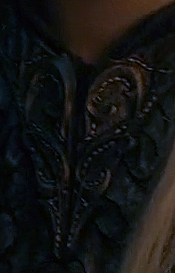Well-Known Member



Intent: A personal armor for Audren
Image Source: NickKellerArt.com, Empire Magazine via LOTR Wiki, The Hobbit: The Desolation of Smaug (movie)
Canon Link: N/A
Restricted Missions: If Required
Primary Source: N/A
PRODUCTION INFORMATION
Manufacturer: Ceredir Industries
Model: Flângren
Affiliation: [member="Audren Sykes"]
Modularity: Superficial - Boots/vambraces/belt can be switched out for similar units, exposed colors may be changed via paint (not adaptive)
Production: Unique
Material: Phrik, Asheran Armorweave, Thermal Gel, Spidersilk Elastex, Shadowsilk, Latoprene
TECHNICAL SPECIFICATIONS
Classification: Multipurpose
Weight: 9kg
Quality: 8
SPECIAL FEATURES
Light
DETAILED SPECIAL FEATURES
Light - Composed of Phrik, armorweave, and other lighter materials rather than heavier, denser ones that would provide more protection.
Strengths:
+ Basic: The armor has a distinct lack of incorporated electronics. While many other armors will include various gadgets, this one won't be adversely affected by EMP or ion strikes.
+ Quality: This armor is designed to provide high-quality protection. The focus is against lightsabers, physical blades, and blasters, but it also protects against weather and kinetic damage.
+ Agility: The armor was designed to minimize loss of agility, which required it be fairly light and unrestricting.
Weaknesses:
- Exposed: Like many other armors designed to preserve mobility, several areas were bypassed. Knees, elbows, neck, and more have only limited coverage, and the head is fully exposed.
- Exposure: While an effort was made to regulate temperature with the thermal gel, the layer is very thin and the effect is minimal. Extreme weather - hot or cold - is not something that can simply be shrugged off.
- Noise: The shoulder armor is composed of scale mail. This can cause unwanted noise, which given Audren's preference to remain quick and quiet can prove unwelcome.
- Kinesis: The protection offered against kinetic damage by the thermal gel is minimal. Even if the plates stop a slugthrower or other hit, the kinetic impact could still cause considerable damage.
- Basic: The armor has a distinct lack of incorporated electronics. No comm units, HUDs, or integrated shielding units. Everything must be carried externally.
- Angles: The angles of the plates and scales allow the potential for incoming damage to slip through the overlap areas. Far more so with the scales given the additional number of pieces.
- Electricity: Due to the Asheran Armorweave's build, it is effectively a large-scale conductor. Electrical attacks are much more dangerous as a result.
DESCRIPTION
In the later decades of the Old Republic, Jedi and Sith wore armor but rarely. Even as the Clone Wars spun into a raging maelstrom, relatively few donned the added protection. They preferred to trust in the Force. It was only once Order 66 became a reality that the use of armor began increasing, and much of that statistic was affected by the sudden loss in the amount of Jedi to compare with. In more recent centuries though, armor has become nigh essential.
The first set of heavy-duty armor that Audren used was built by Vanir Technologies. It was an excellent set, lightweight while still providing high-quality protection. It lasted for years, from Padawan to Master, which was impressive considering how many battles it had seen. Yet there came a time when it was damaged beyond repair. The Kinetic Gel was more stiff board than cushion; the dallorian alloy plating was cracked, chipped, and some pieces could fold almost in half; and the Shark Skin armorweave had tears centimeters in length and bald patches where there should have been microscopic barbs.
In theory, a second set could have been purchased, or a replacement commissioned. Vanir was known for - among many things - their armor quality. However, unlike before he now had his own company, one that could create armor. True, this set would be the first foray away from mass-produced armors and into higher-quality protection, but he was confident in the smiths' skills. And Vanir would still make some profit...they made good stuff, after all.
The base layer was spidersilk elastex, both blaster- and vibroblade-resistant. Next came a thin layer of thermal gel. This would serve a dual purpose: provide a measure of temperature control and kinetic protection. Then came the armorweave, specifically Asheran armorweave. Lightsaber, blaster, and blade-resistant material created by Vanir Technologies. It was the same stuff that made up the Shark Skin armorweave in the old armor, just not as shaped and more suitable for wearing under other elements. Phrik plates were used for the torso. Rather than having just a single plate, multiple smaller plates were used. There is minor overlap on the plates to prevent sudden gaps from appearing during the intense activity often seen in fights. Rather than use plates for the arms and shoulders however, scales - almost artistic in design - were fashioned into mail to preserve mobility. Larger pieces served as pauldrons. Near the center of the torso, the two styles merge together into an ornately-wrought mid-sized collar, also of phrik. Chances of beheading during a lightsaber duel tended to be high, after all. Other parts, such as the vambraces and shin areas of the boots, included phrik as well.
There were negatives, of course. The refined phrik gleamed in light, the plates rubbed against each other, and the mail rattled. This directly contradicted the Sephi's habit of moving silently and not drawing much attention to himself when possible. Not that wearing armor of this sort was subtle, but one could hope. To combat the sounds, shadowsilk was used. Covered by the armor as it was, it just dampens the sounds yet has no effect on the gleam. Latoprene was the solution here, a coating that would dull the metal and allow it to blend better. Due to their smaller size, the scales carry a thinner coating than the plates. It was decided to exclude built-in electronics: while such devices could prove useful, an armor that relied on their presence would be crippled without them. That is not to say the devices cannot be added, as there are slots specifically built for certain types of devices, but they are not ingrained.
The final result was heavier than the Vanir Technology armor and probably much more expensive. However, it was custom-fitted to the Sephi from the ground up and opened up the gateways for future sales of high-quality armors through Ceredir Industries.








